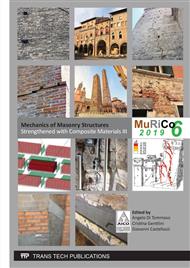p.9
p.15
p.23
p.30
p.37
p.44
p.50
p.57
p.65
Numerical Modelling of the Experimental Response of SRG Systems
Abstract:
Modern repairing and retrofitting methods for existing structures make use of composite materials, consisting of high strength textiles and a matrix, which can be either polymeric or inorganic. These kinds of techniques have been largely applied to masonry structures, since they significantly improve structural performance with a small increase of weight and a minimum invasiveness. However, the application of organic gluing agents on masonry has revealed some well-known drawbacks, which are almost all overcome resorting to inorganic matrixes, namely cement or lime mortars. An entire class of composites is thus identified as TRM (Textile Reinforced Mortars) or FRCM (Fibre Reinforced Cementitious Matrices). Among them, Steel Reinforced Grout (SRG) are characterized by Ultra High Tensile Strength Steel (UHTSS) cords embedded in mortar matrix and their use to improve the structural performance of existing historical masonry buildings is becoming more and more diffused. Qualification tests and acceptance criteria for SRG have just been defined. Nonetheless, numerical simulation of current available test procedures is mandatory to identify peculiar aspects of the response that at a following stage become an integral part of large scale models, when entire reinforced structures or portions need to be analysed. To this end, this work presents the numerical modelling of two different direct tensile tests on SRG systems: the Clamping-grip setup (RILEM Technical Committee 232-TDT 2016) and the Clevis-grip setup (ICC-ES AC434 2016). Numerical models able to replicate experimental tests and catch fundamental differences in their failure mechanisms are present
Info:
Periodical:
Pages:
37-43
Citation:
Online since:
August 2019
Price:
Сopyright:
© 2019 Trans Tech Publications Ltd. All Rights Reserved
Share:
Citation:


